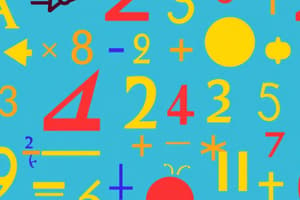Podcast
Questions and Answers
What is mathematics defined as?
What is mathematics defined as?
- The abstract science of number, quantity, and space (correct)
- The art of drawing and painting
- The study of living organisms
- The study of chemical reactions
What does arithmetic primarily involve?
What does arithmetic primarily involve?
- The study of geometric shapes
- The study of algebraic equations
- The study of rates of change
- The study of numbers and operations between them (correct)
Which operation is the inverse of addition?
Which operation is the inverse of addition?
- Subtraction (correct)
- Multiplication
- Division
- Exponentiation
What does algebra use to represent numbers and mathematical objects?
What does algebra use to represent numbers and mathematical objects?
In algebra, what are mathematical statements expressing equality of two expressions called?
In algebra, what are mathematical statements expressing equality of two expressions called?
What is the highest power of the variable in a linear equation?
What is the highest power of the variable in a linear equation?
Which field of mathematics deals with the properties of points, lines, and shapes?
Which field of mathematics deals with the properties of points, lines, and shapes?
What is a line in geometry?
What is a line in geometry?
Which theorem relates the sides of a right triangle?
Which theorem relates the sides of a right triangle?
What ratio does sine (sin) represent in a right triangle?
What ratio does sine (sin) represent in a right triangle?
What is calculus primarily the study of?
What is calculus primarily the study of?
What does the derivative of a function represent?
What does the derivative of a function represent?
What is statistics the science of?
What is statistics the science of?
What is probability a measure of?
What is probability a measure of?
Which area of mathematics deals with discrete, rather than continuous, structures?
Which area of mathematics deals with discrete, rather than continuous, structures?
What does set theory deal with?
What does set theory deal with?
Real Analysis provides a rigorous foundation for which area of mathematics?
Real Analysis provides a rigorous foundation for which area of mathematics?
Complex analysis investigates functions of what type of numbers?
Complex analysis investigates functions of what type of numbers?
Topology studies the properties of spaces that are preserved under what type of deformations?
Topology studies the properties of spaces that are preserved under what type of deformations?
Numerical analysis is devoted to developing algorithms for solving what types of problems?
Numerical analysis is devoted to developing algorithms for solving what types of problems?
Flashcards
Mathematics
Mathematics
The abstract science of number, quantity, and space.
Arithmetic
Arithmetic
The study of numbers and basic operations like addition, subtraction, multiplication, and division.
Addition
Addition
Combining two numbers into a single number, called the sum.
Subtraction
Subtraction
Signup and view all the flashcards
Multiplication
Multiplication
Signup and view all the flashcards
Division
Division
Signup and view all the flashcards
Algebra
Algebra
Signup and view all the flashcards
Equations
Equations
Signup and view all the flashcards
Linear Equations
Linear Equations
Signup and view all the flashcards
Quadratic Equations
Quadratic Equations
Signup and view all the flashcards
Factoring
Factoring
Signup and view all the flashcards
Geometry
Geometry
Signup and view all the flashcards
Point
Point
Signup and view all the flashcards
Line
Line
Signup and view all the flashcards
Angle
Angle
Signup and view all the flashcards
Trigonometry
Trigonometry
Signup and view all the flashcards
Sine (sin)
Sine (sin)
Signup and view all the flashcards
Calculus
Calculus
Signup and view all the flashcards
Differential Calculus
Differential Calculus
Signup and view all the flashcards
Integral Calculus
Integral Calculus
Signup and view all the flashcards
Study Notes
- Mathematics is the abstract science of number, quantity, and space.
- Math can be studied in its own right (pure mathematics), or as it is applied to other disciplines such as physics and engineering (applied mathematics).
Arithmetic
- Arithmetic involves the study of numbers, especially the properties of the traditional operations between them—addition, subtraction, multiplication, and division.
- Addition is the most basic operation of arithmetic.
- It combines two numbers into a single number, the sum.
- Subtraction is the inverse of addition.
- It finds the difference between two numbers.
- Multiplication is equivalent to adding a number to itself a certain number of times.
- Division is the inverse of multiplication.
- It finds how many times one number is contained in another.
Algebra
- Algebra is a generalization of arithmetic that uses symbols to represent numbers and other mathematical objects.
- It uses variables to represent quantities without fixed values.
- Equations are mathematical statements that express the equality of two expressions.
- Solving an equation involves finding the value(s) of the variable(s) that make the equation true.
- Linear equations are equations in which the highest power of the variable is 1.
- Quadratic equations are equations in which the highest power of the variable is 2.
- Factoring is the process of breaking down a number or expression into its factors.
- The quadratic formula provides the solutions to any quadratic equation in the form ax^2 + bx + c = 0.
Geometry
- Geometry is concerned with the properties and relations of points, lines, surfaces, solids, and higher dimensional analogs.
- Euclidean geometry is based on axioms and theorems of Euclid.
- Key concepts include points, lines, angles, and shapes.
- A point is a location in space.
- A line is a straight, one-dimensional figure extending infinitely in both directions.
- An angle is formed by two lines that share a common endpoint (vertex).
- Triangles, quadrilaterals, circles, and polygons are fundamental shapes in geometry.
- The Pythagorean theorem relates the sides of a right triangle: a^2 + b^2 = c^2, where c is the hypotenuse.
- Area calculations include determining the space occupied by two-dimensional shapes.
- Volume calculations determine the space occupied by three-dimensional objects.
- Coordinate geometry uses a coordinate system to represent geometric shapes and figures.
Trigonometry
- Trigonometry studies the relationships between the angles and sides of triangles.
- It focuses on trigonometric functions such as sine, cosine, and tangent.
- Sine (sin) is the ratio of the opposite side to the hypotenuse in a right triangle.
- Cosine (cos) is the ratio of the adjacent side to the hypotenuse in a right triangle.
- Tangent (tan) is the ratio of the opposite side to the adjacent side in a right triangle.
- The unit circle provides a visual representation of trigonometric functions.
- Trigonometric identities are equations involving trigonometric functions that are always true.
- Trigonometry is used in navigation, surveying, and physics.
Calculus
- Calculus is the study of continuous change.
- It is divided into differential calculus and integral calculus.
- Differential calculus deals with the rate of change of a function.
- The derivative of a function represents its instantaneous rate of change at a point.
- Integral calculus deals with the accumulation of quantities.
- The integral of a function represents the area under its curve.
- Limits are a fundamental concept in calculus.
- They describe the behavior of a function as its input approaches a particular value.
- The fundamental theorem of calculus relates differentiation and integration.
Statistics and Probability
- Statistics is the science of collecting, analyzing, interpreting, and presenting data.
- Descriptive statistics summarize and describe the main features of a dataset.
- Inferential statistics use sample data to make inferences about a population.
- Probability is a measure of the likelihood that an event will occur.
- Probability values range from 0 to 1.
- A probability of 0 means the event is impossible.
- A probability of 1 means the event is certain.
- The normal distribution is a common probability distribution in statistics.
- Hypothesis testing involves using statistical methods to test a claim or hypothesis about a population.
Discrete Mathematics
- Discrete mathematics deals with mathematical structures that are fundamentally discrete rather than continuous.
- It includes topics such as logic, set theory, combinatorics, graph theory, and number theory.
- Logic studies the principles of valid reasoning and inference.
- Set theory deals with collections of objects called sets.
- Combinatorics is concerned with counting and arranging objects.
- Graph theory studies the properties of graphs, which are mathematical structures used to model relationships between objects.
- Number theory deals with the properties of integers.
Real Analysis
- The branch of mathematical analysis that studies the behavior of real numbers, sequences and series of real numbers, and real functions.
- It provides a rigorous foundation for calculus.
- Focuses on concepts like convergence, continuity, differentiation, and integration within the real number system.
- Important theorems include the Bolzano-Weierstrass theorem, the Intermediate Value Theorem, and the Mean Value Theorem.
- Sequences and Series: Examination of the convergence and divergence of infinite sequences and series.
- Functions of a Real Variable: Study of the properties of real-valued functions, including continuity, differentiability, and integrability.
Complex Analysis
- The branch of mathematical analysis that investigates functions of complex numbers.
- Complex numbers extend the real number system by including the imaginary unit "i," where i² = -1.
- Complex functions can be differentiated and integrated, leading to powerful results such as Cauchy's integral theorem.
- Holomorphic Functions: Functions that are complex differentiable in an open set.
- Complex Integration: Integration of complex functions along paths in the complex plane.
- Residue Theorem: A fundamental result that relates the integral of a complex function around a closed curve to the residues of its singularities.
Topology
- A branch of mathematics that studies the properties of spaces that are preserved under continuous deformations, such as stretching, twisting, crumpling, and bending, but not tearing or gluing.
- Point-Set Topology:
- Basic concepts include open sets, closed sets, neighborhoods, limit points, and continuity.
- Study of topological spaces and their properties, such as compactness, connectedness, and separation axioms.
- Algebraic Topology:
- Uses algebraic tools to study topological spaces.
- Fundamental groups, homology, and cohomology are used to classify topological spaces.
Numerical Analysis
- An area of mathematics and computer science devoted to developing, analyzing, and implementing algorithms for solving mathematical problems numerically.
- Approximation Theory:
- Deals with approximating functions or data using simpler functions, such as polynomials or splines.
- Interpolation and curve fitting techniques.
- Numerical Linear Algebra:
- Numerical methods for solving linear systems, eigenvalue problems, and singular value decomposition.
- Direct methods (e.g., Gaussian elimination) and iterative methods (e.g., Jacobi, Gauss-Seidel).
Studying That Suits You
Use AI to generate personalized quizzes and flashcards to suit your learning preferences.




